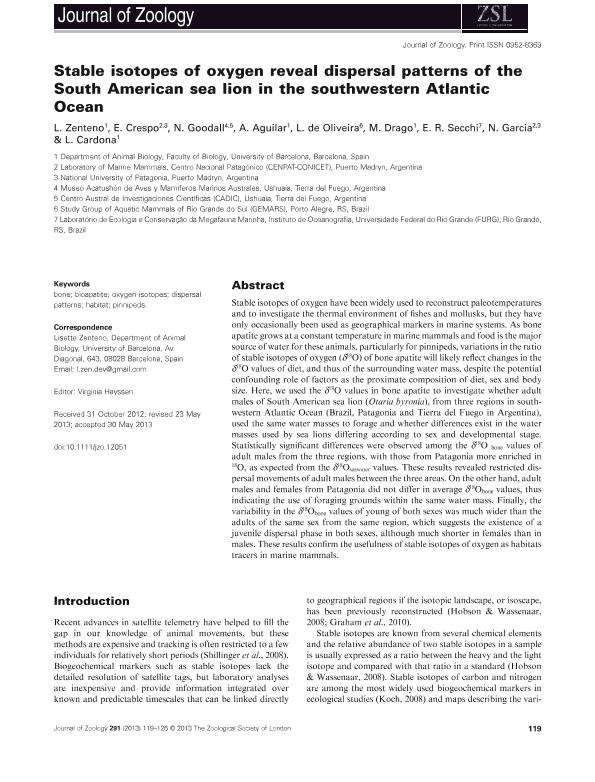Mostrar el registro sencillo del ítem
dc.contributor.author
Zenteno, L.
dc.contributor.author
Crespo, Enrique Alberto

dc.contributor.author
Prosser Goodall, Rae Natalie
dc.contributor.author
Aguilar, A.
dc.contributor.author
de Oliveira, L.
dc.contributor.author
Drago, M.
dc.contributor.author
Secchi, Eduardo Resende
dc.contributor.author
Garcia, Nestor Anibal

dc.contributor.author
Cardona, L.
dc.date.available
2016-05-13T15:09:23Z
dc.date.issued
2013-12
dc.identifier.citation
Zenteno, L.; Crespo, Enrique Alberto; Prosser Goodall, Rae Natalie ; Aguilar, A.; de Oliveira, L. ; et al.; Stable isotopes of oxygen reveal dispersal patterns of the South American sea lion in the southwestern Atlantic Ocean; Wiley; Journal of Zoology; 291; 2; 12-2013; 119-126
dc.identifier.issn
0952-8369
dc.identifier.uri
http://hdl.handle.net/11336/5642
dc.description.abstract
Stable isotopes of oxygen have been widely used to reconstruct paleotemperatures and to investigate the thermal environment of fishes and mollusks, but they have only occasionally been used as geographical markers in marine systems. As bone apatite grows at a constant temperature in marine mammals and food is the major source of water for these animals, particularly for pinnipeds, variations in the ratio of stable isotopes of oxygen (δ18O) of bone apatite will likely reflect changes in the δ18O values of diet, and thus of the surrounding water mass, despite the potential confounding role of factors as the proximate composition of diet, sex and body size. Here, we used the δ18O values in bone apatite to investigate whether adult males of South American sea lion (Otaria byronia), from three regions in southwestern Atlantic Ocean (Brazil, Patagonia and Tierra del Fuego in Argentina), used the same water masses to forage and whether differences exist in the water masses used by sea lions differing according to sex and developmental stage. Statistically significant differences were observed among the δ18O bone values of adult males from the three regions, with those from Patagonia more enriched in 18O, as expected from the δ18Oseawater values. These results revealed restricted dispersal movements of adult males between the three areas. On the other hand, adult males and females from Patagonia did not differ in average δ18Obone values, thus indicating the use of foraging grounds within the same water mass. Finally, the variability in the δ18Obone values of young of both sexes was much wider than the adults of the same sex from the same region, which suggests the existence of a juvenile dispersal phase in both sexes, although much shorter in females than in males. These results confirm the usefulness of stable isotopes of oxygen as habitats tracers in marine mammals.
dc.format
application/pdf
dc.language.iso
eng
dc.publisher
Wiley

dc.rights
info:eu-repo/semantics/openAccess
dc.rights.uri
https://creativecommons.org/licenses/by-nc-sa/2.5/ar/
dc.subject
Bone Bioapatite
dc.subject
Oxigen Isotopes
dc.subject
Dispersal Patterns
dc.subject
Pinnipeds
dc.subject.classification
Ecología

dc.subject.classification
Ciencias Biológicas

dc.subject.classification
CIENCIAS NATURALES Y EXACTAS

dc.title
Stable isotopes of oxygen reveal dispersal patterns of the South American sea lion in the southwestern Atlantic Ocean
dc.type
info:eu-repo/semantics/article
dc.type
info:ar-repo/semantics/artículo
dc.type
info:eu-repo/semantics/publishedVersion
dc.date.updated
2016-04-28T14:49:29Z
dc.journal.volume
291
dc.journal.number
2
dc.journal.pagination
119-126
dc.journal.pais
Reino Unido

dc.journal.ciudad
Londres
dc.description.fil
Fil: Zenteno, L.. Universidad de Barcelona; España
dc.description.fil
Fil: Crespo, Enrique Alberto. Consejo Nacional de Investigaciones Científicas y Técnicas. Centro Nacional Patagónico; Argentina. Universidad Nacional de la Patagonia "San Juan Bosco"; Argentina
dc.description.fil
Fil: Prosser Goodall, Rae Natalie . Consejo Nacional de Investigaciones Científicas y Técnicas. Centro Austral de Investigaciones Científicas; Argentina
dc.description.fil
Fil: Aguilar, A.. Universidad de Barcelona; España
dc.description.fil
Fil: de Oliveira, L. . Grupo de Estudos de Mamíferos Aquáticos do Rio Grande do Sul; Brasil
dc.description.fil
Fil: Drago, M.. Universidad de Barcelona; España
dc.description.fil
Fil: Secchi, Eduardo Resende. Universidade Federal do Rio Grande do Sul; Brasil
dc.description.fil
Fil: Garcia, Nestor Anibal. Consejo Nacional de Investigaciones Científicas y Técnicas. Centro Nacional Patagónico; Argentina. Universidad Nacional de la Patagonia "San Juan Bosco"; Argentina
dc.description.fil
Fil: Cardona, L.. Universidad de Barcelona; España
dc.journal.title
Journal of Zoology

dc.relation.alternativeid
info:eu-repo/semantics/altIdentifier/url/http://onlinelibrary.wiley.com/wol1/doi/10.1111/jzo.12051/abstract
dc.relation.alternativeid
info:eu-repo/semantics/altIdentifier/doi/http://dx.doi.org/10.1111/jzo.12051
dc.relation.alternativeid
info:eu-repo/semantics/altIdentifier/doi/10.1111/jzo.12051
Archivos asociados
